美国UCLA医院的服务理念
- 格式:wps
- 大小:48.50 KB
- 文档页数:6
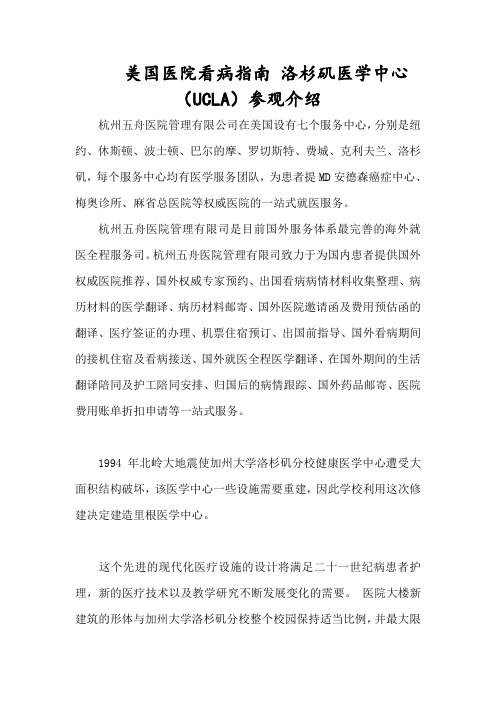
美国医院看病指南洛杉矶医学中心(UCLA)参观介绍杭州五舟医院管理有限公司在美国设有七个服务中心,分别是纽约、休斯顿、波士顿、巴尔的摩、罗切斯特、费城、克利夫兰、洛杉矶,每个服务中心均有医学服务团队,为患者提MD安德森癌症中心、梅奥诊所、麻省总医院等权威医院的一站式就医服务。
杭州五舟医院管理有限司是目前国外服务体系最完善的海外就医全程服务司。
杭州五舟医院管理有限司致力于为国内患者提供国外权威医院推荐、国外权威专家预约、出国看病病情材料收集整理、病历材料的医学翻译、病历材料邮寄、国外医院邀请函及费用预估函的翻译、医疗签证的办理、机票住宿预订、出国前指导、国外看病期间的接机住宿及看病接送、国外就医全程医学翻译、在国外期间的生活翻译陪同及护工陪同安排、归国后的病情跟踪、国外药品邮寄、医院费用账单折扣申请等一站式服务。
1994年北岭大地震使加州大学洛杉矶分校健康医学中心遭受大面积结构破坏,该医学中心一些设施需要重建,因此学校利用这次修建决定建造里根医学中心。
这个先进的现代化医疗设施的设计将满足二十一世纪病患者护理,新的医疗技术以及教学研究不断发展变化的需要。
医院大楼新建筑的形体与加州大学洛杉矶分校整个校园保持适当比例,并最大限度的采用自然采光。
此百万米平方,十层楼高(地上八层)的罗纳德·里根加利福尼亚大学洛杉矶分校医学中心为一结构栋梁。
其为最先通过新防震法规加州医院之一,设计为能够抵挡8级的地震。
医院的两个主要入口以巨大的天蓬为主要特征。
其东边的入口面对西木大道与校园,而西边的入口面对凯利大道与西木居住区。
医院大楼在第三层明显折入,以便与相关邻接的低层建筑协调。
上部的主体结构变化为三角形与三个半圆形高塔,设有单人护理病房及特别护理病房。
巨大的建筑集聚连接了分成若干功能块的塔楼,创造出了一个卓然不群的独特的医院建筑形象。
遮阳罩及切入的凹口进一步缩小了建筑外观体量。
高塔之间的屋顶露台则采用了特别的景观设计,以满足不同的康复治疗效果的需求。
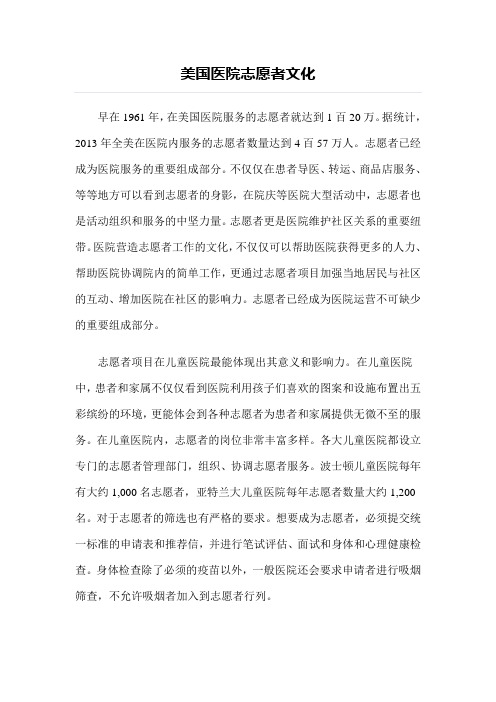
美国医院志愿者文化早在1961年,在美国医院服务的志愿者就达到1百20万。
据统计,2013年全美在医院内服务的志愿者数量达到4百57万人。
志愿者已经成为医院服务的重要组成部分。
不仅仅在患者导医、转运、商品店服务、等等地方可以看到志愿者的身影,在院庆等医院大型活动中,志愿者也是活动组织和服务的中坚力量。
志愿者更是医院维护社区关系的重要纽带。
医院营造志愿者工作的文化,不仅仅可以帮助医院获得更多的人力、帮助医院协调院内的简单工作,更通过志愿者项目加强当地居民与社区的互动、增加医院在社区的影响力。
志愿者已经成为医院运营不可缺少的重要组成部分。
志愿者项目在儿童医院最能体现出其意义和影响力。
在儿童医院中,患者和家属不仅仅看到医院利用孩子们喜欢的图案和设施布置出五彩缤纷的环境,更能体会到各种志愿者为患者和家属提供无微不至的服务。
在儿童医院内,志愿者的岗位非常丰富多样。
各大儿童医院都设立专门的志愿者管理部门,组织、协调志愿者服务。
波士顿儿童医院每年有大约1,000名志愿者,亚特兰大儿童医院每年志愿者数量大约1,200名。
对于志愿者的筛选也有严格的要求。
想要成为志愿者,必须提交统一标准的申请表和推荐信,并进行笔试评估、面试和身体和心理健康检查。
身体检查除了必须的疫苗以外,一般医院还会要求申请者进行吸烟筛查,不允许吸烟者加入到志愿者行列。
经过申请和面试,申请者才能成功成为志愿者。
为了志愿者服务的连续性,志愿者必须保证能够在一年内每周贡献4小时的时间。
有些儿童医院也降低标准,例如洛杉矶儿童医院要求志愿者至少在未来的6个月每周有4个小时进行志愿者服务。
志愿者服务的内容也大体可以分为直接患者接触类和后台服务类。
作为医院正式而且非常重要的项目,医院通常对于志愿者提供正式的岗前培训(orientation)。
岗前培训一般不少于3个小时。
对于一些要求更加严格、更加正式的志愿者项目,新的志愿者前两个月要进行基础的“培训项目”。
在洛杉矶儿童医院的“培训项目”中,志愿者需要陪伴患者和家属、并作为向导带着患者和家属到诊疗和检查的地方。
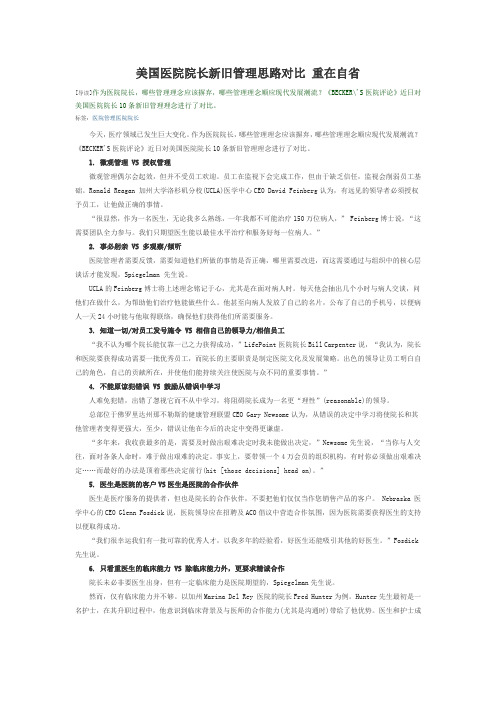
美国医院院长新旧管理思路对比重在自省[导读]作为医院院长,哪些管理理念应该摒弃,哪些管理理念顺应现代发展潮流?《BECKER\'S医院评论》近日对美国医院院长10条新旧管理理念进行了对比。
标签:医院管理医院院长今天,医疗领域已发生巨大变化。
作为医院院长,哪些管理理念应该摒弃,哪些管理理念顺应现代发展潮流?《BECKER'S医院评论》近日对美国医院院长10条新旧管理理念进行了对比。
1. 微观管理 VS 授权管理微观管理偶尔会起效,但并不受员工欢迎。
员工在监视下会完成工作,但由于缺乏信任,监视会削弱员工基础。
Ronald Reagan 加州大学洛杉矶分校(UCLA)医学中心CEO David Feinberg认为,有远见的领导者必须授权予员工,让他做正确的事情。
“很显然,作为一名医生,无论我多么熟练,一年我都不可能治疗150万位病人,” Feinberg博士说,“这需要团队全力参与。
我们只期望医生能以最佳水平治疗和服务好每一位病人。
”2. 事必躬亲 VS 多观察/倾听医院管理者需要反馈,需要知道他们所做的事情是否正确,哪里需要改进,而这需要通过与组织中的核心层谈话才能发现,Spiegelman 先生说。
UCLA的Feinberg博士将上述理念铭记于心,尤其是在面对病人时。
每天他会抽出几个小时与病人交谈,问他们在做什么,为帮助他们治疗他能做些什么。
他甚至向病人发放了自己的名片,公布了自己的手机号,以便病人一天24小时能与他取得联络,确保他们获得他们所需要服务。
3. 知道一切/对员工发号施令 VS 相信自己的领导力/相信员工“我不认为哪个院长能仅靠一己之力获得成功,”LifePoint医院院长Bill Carpenter说,“我认为,院长和医院要获得成功需要一批优秀员工,而院长的主要职责是制定医院文化及发展策略。
出色的领导让员工明白自己的角色,自己的贡献所在,并使他们能持续关注使医院与众不同的重要事情。
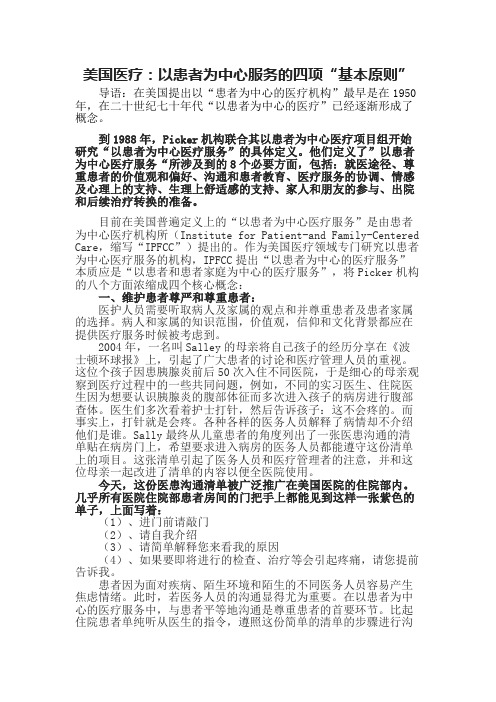
美国医疗:以患者为中心服务的四项“基本原则”导语:在美国提出以“患者为中心的医疗机构”最早是在1950年,在二十世纪七十年代“以患者为中心的医疗”已经逐渐形成了概念。
到1988年,Picker机构联合其以患者为中心医疗项目组开始研究“以患者为中心医疗服务”的具体定义。
他们定义了”以患者为中心医疗服务“所涉及到的8个必要方面,包括:就医途径、尊重患者的价值观和偏好、沟通和患者教育、医疗服务的协调、情感及心理上的支持、生理上舒适感的支持、家人和朋友的参与、出院和后续治疗转换的准备。
目前在美国普遍定义上的“以患者为中心医疗服务”是由患者为中心医疗机构所(Institute for Patient-and Family-Centered Care,缩写“IPFCC”)提出的。
作为美国医疗领域专门研究以患者为中心医疗服务的机构,IPFCC提出“以患者为中心的医疗服务”本质应是“以患者和患者家庭为中心的医疗服务”,将Picker机构的八个方面浓缩成四个核心概念:一、维护患者尊严和尊重患者:医护人员需要听取病人及家属的观点和并尊重患者及患者家属的选择。
病人和家属的知识范围,价值观,信仰和文化背景都应在提供医疗服务时候被考虑到。
2004年,一名叫Salley的母亲将自己孩子的经历分享在《波士顿环球报》上,引起了广大患者的讨论和医疗管理人员的重视。
这位个孩子因患胰腺炎前后50次入住不同医院,于是细心的母亲观察到医疗过程中的一些共同问题,例如,不同的实习医生、住院医生因为想要认识胰腺炎的腹部体征而多次进入孩子的病房进行腹部查体。
医生们多次看着护士打针,然后告诉孩子:这不会疼的。
而事实上,打针就是会疼。
各种各样的医务人员解释了病情却不介绍他们是谁。
Sally最终从儿童患者的角度列出了一张医患沟通的清单贴在病房门上,希望要求进入病房的医务人员都能遵守这份清单上的项目。
这张清单引起了医务人员和医疗管理者的注意,并和这位母亲一起改进了清单的内容以便全医院使用。

厚朴方舟健康管理有限司致力于为国内患者提供国外权威医院推荐、国外权威专家预约、出国看病病情材料收集整理、病历材料的医学翻译、病历材料邮寄、国外医院邀请函及费用预估函的翻译、医疗签证的办理、机票住宿预订、出国前指导、国外看病期间的接机住宿及看病接送、国外就医全程医学翻译、在国外期间的生活翻译陪同及护工陪同安排、归国后的病情跟踪、国外药品邮寄、医院费用账单折扣申请等一站式服务。
且在国外拥有自己的公寓——厚朴之家。
为患者及家属提供温馨的生活环境。
加州大学洛杉矶分校医学中心建于1955年,于2008年更名为罗纳德.里根(Ronald Regan 第四十任美国总统)医疗中心。
该院位于气候宜人华人众多的洛杉矶,下辖8所医院,在美国综合排名第五,美国西海岸综合排名第一,科研能力排名第四,先后有14人获得诺贝尔奖,艾滋病即于1981年在该院首次发现。
医学中心建设耗资8亿美元,可抵抗里氏8级地震,被称为“世界上技术最先进的医院”。
医疗中心共有普通住院病床540张,康复病床11张,儿科病床100张,手术室23间,1500名全职医生,2500多名辅助支持员工,年住院患者达44466人次,年住院手术量达11344人次,年急诊人次达79万人次,平均住院日6.79天。
该院在很多学科处于世界领先水平,是好莱坞影星和众多政要的首选医院。
里根总统的主治保健医院。
如今更是发展为了世界级的优秀医院,新建的医疗大楼医院每一层都是按照某一特定专业所需配备整套必要的支持设备和物资,每一层都有各自的药房、透析室、呼吸机辅助治疗室和住院医师的休息室,人性化的设计让病人免去了奔波的疲劳。
每一个病房若有需要,都可以转换成重症监护病房,这样可以在同一个房间为重病人提供持续的照护。
手术室配备的是全视听集成系统及尖端医疗设备。
拥有多个创伤病房和专业CT扫描仪的一级创伤中心,使医生一旦到达病房就能很快的知道病患出现的问题在哪。
重症监护室采用“瞄准线”切入法以确保重症病患得到360度无死角的照护。
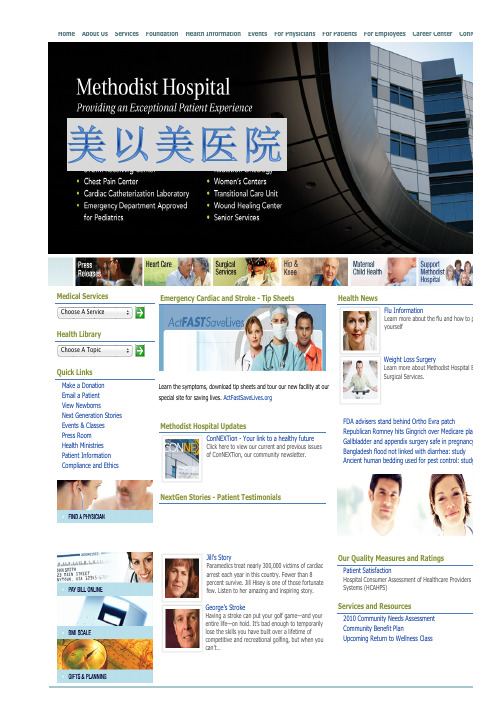
Home About Us Services Foundation Health Information Events For Physicians For Patients For Employees Career Center ConNEXTionMedical Services Choose A ServiceHealth Library Choose A TopicQuick LinksMake a Donation Email a Patient View Newborns Next Generation Stories Events & Classes Press RoomHealth Ministries Patient Information Compliance and Ethics Emergency Cardiac and Stroke - Tip SheetsLearn the symptoms, download tip sheets and tour our new facility at ourspecial site for saving lives. Methodist Hospital UpdatesConNEXTion - Your link to a healthy futureClick here to view our current and previous issuesof ConNEXTion, our community newsletter.NextGen Stories - Patient TestimonialsJill's StoryParamedics treat nearly 300,000 victims of cardiacarrest each year in this country. Fewer than 8percent survive. Jill Hisey is one of those fortunatefew. Listen to her amazing and inspiring story.George's StrokeHaving a stroke can put your golf game—and yourentire life—on hold. It’s bad enough to temporarilylose the skills you have built over a lifetime ofcompetitive and recreational golfing, but when youcan’t…Health NewsFlu InformationLearn more about the flu and how to protectyourselfWeight Loss SurgeryLearn more about Methodist Hospital BariatricSurgical Services.FDA advisers stand behind Ortho Evra patchRepublican Romney hits Gingrich over Medicare planGallbladder and appendix surgery safe in pregnancyBangladesh flood not linked with diarrhea: studyAncient human bedding used for pest control: studyOur Quality Measures and RatingsPatient SatisfactionHospital Consumer Assessment of Healthcare Providers andSystems (HCAHPS)Services and Resources2010 Community Needs AssessmentCommunity Benefit PlanUpcoming Return to Wellness Class医院情况简介:美以美医院是一家美国知名的大型综合医院,设有肿瘤,妇产,心脑,伤科,精神,骨科等多个先进的医学科诊疗中心。
ucla校训
UCLA的校训是“Fiat Lux”,意为“要有光”,这个校训表达了创造和启迪的理念。
UCLA的校训源自圣经《创世纪》中的“要有光、就有了光”,意味着学校致力于培养出具有智慧、创造力和领导能力的栋梁之才,这些人才将以社会的贡献为目标,成为推动人类前进的力量。
此外,UCLA的校训还体现了学校的教育理念和核心价值观,这些理念和价值观在学校的教学、科研和社会服务中得到了充分体现。
校训“Fiat Lux”在学校教育和发展中发挥了重要作用,使学校内外共同形成了正向、积极的学术、文化和社交氛围。
同时,UCLA的校训也对学生的成长产生了重要影响。
它启迪学生在学术、社交、职业等方面全面发展,培养他们的独立思考和创新精神,并帮助他们培养自信、积极向上的心态和积极乐观的人生态度。
同时,校训也引导学生将所学知识用于实践,注重知识的启蒙和个性的培养,促进学生自由思考和自主学习。
总之,UCLA的校训“Fiat Lux”是学校的精神象征,它不仅表达了学校的教育理念和追求,也对学生的成长和学校文化产生了深远影响。
1。
有感于美国医院的护理服务内涵
陈健
【期刊名称】《上海护理》
【年(卷),期】2002(002)003
【摘要】@@ 应美国护士学会American Nurses Association(ANA)的邀请,笔者于2001年8月赴美考察,参观了华盛顿美国护士学会、洛杉矶USC University Hospital南加大医院、斯坦福大学等.美国医院现代化的硬件设施和以人为本的管理理念及诚信意识,拓展了我们的视野,得到极好启迪.
【总页数】2页(P56-57)
【作者】陈健
【作者单位】解放军第四五五医院,200052
【正文语种】中文
【中图分类】R47
【相关文献】
1.丰富护理服务内涵打造具有眼科专科特色的“关爱、人性、五心级”优质护理服务病房
2.浅析责任制整体护理思维与优质护理服务内涵关系
3.浅析责任制整体护理思维与优质护理服务内涵关系
4.开展护理服务文化建设深化优质护理服务内涵
5.强化质量管理,提升服务内涵,加速人才培养,着力打造中医特色护理服务品牌——记湖南中医药大学第二附属医院护理团队
因版权原因,仅展示原文概要,查看原文内容请购买。
美国最好医院加州大学洛杉矶分校医学中心(UCLA)就医攻略指南杭州五舟医院管理有限公司在美国设有七个服务中心,分别是纽约、休斯顿、波士顿、巴尔的摩、罗切斯特、费城、克利夫兰、洛杉矶,每个服务中心均有医学服务团队,为患者提MD安德森癌症中心、梅奥诊所、麻省总医院等权威医院的一站式就医服务。
杭州五舟医院管理有限司是目前国外服务体系最完善的海外就医全程服务司。
杭州五舟医院管理有限司致力于为国内患者提供国外权威医院推荐、国外权威专家预约、出国看病病情材料收集整理、病历材料的医学翻译、病历材料邮寄、国外医院邀请函及费用预估函的翻译、医疗签证的办理、机票住宿预订、出国前指导、国外看病期间的接机住宿及看病接送、国外就医全程医学翻译、在国外期间的生活翻译陪同及护工陪同安排、归国后的病情跟踪、国外药品邮寄、医院费用账单折扣申请等一站式服务。
加州大学洛杉矶分校医学中心建于1955年,于2008年更名为罗纳德.里根(Ronald Regan 第四十任美国总统)医疗中心。
该院位于气候宜人华人众多的洛杉矶,下辖8所医院,在美国综合排名第五,美国西海岸综合排名第一,科研能力排名第四,先后有14人获得诺贝尔奖,艾滋病即于1981年在该院首次发现。
医学中心建设耗资8亿美元,可抵抗里氏8级地震,被称为“世界上技术最先进的医院”。
医疗中心共有普通住院病床540张,康复病床11张,儿科病床100张,手术室23间,1500名全职医生,2500多名辅助支持员工,年住院患者达44466人次,年住院手术量达11344人次,年急诊人次达79万人次,平均住院日6.79天。
该院在很多学科处于世界领先水平,是好莱坞影星和众多政要的首选医院。
里根总统的主治保健医院。
如今更是发展为了世界级的优秀医院,新建的医疗大楼医院每一层都是按照某一特定专业所需配备整套必要的支持设备和物资,每一层都有各自的药房、透析室、呼吸机辅助治疗室和住院医师的休息室,人性化的设计让病人免去了奔波的疲劳。
Mark Goulston, M.D.Posted: November 4, 2010 09:00 AMBIOBecome a FanGet Email AlertsBloggers' IndexPutting the 'Care' Back in Health Care -- the UCLA TransformationMe:Can you please connect me to Dr. Ian Cook?UCLA Hospital operator (in a super friendly and super helpful voice):I'd be pleased to connect you and would you like his direct number for future reference? I'd never heard such a pleasant and helpful response from an operator. It was not the UCLA that I remembered when I trained their as a psychiatric resident in the late 1970's. For the longest time UCLA Medical Center received an A for care and a D for caring. When I firsthand experienced their caring and learned that UCLA Health System's mission is "seeking to heal humankind, one patient at a time" I needed to hear more.I had to find out what had happened and if what I hoped was really true, that UCLA had become an oasis and hopefully a model for caring in health care that is too often devoid of it. I reached out to Roxanne Moster, Director of UCLA Health Sciences Media Relations to find out more. In my email I asked her, "What has happened to UCLA? It's so different than I remember it when I was an Assistant Clinical Professor of Psychiatry there." I was especially interested because the CEO of the whole shebang was David Feinberg, M.D. who I remembered as the psychiatric resident I had helped train in the 1980's.I couldn't be prouder when this is what she wrote me:For most hospital CEOs, leading a medical center equipped with the newest and most sophisticated medical technologies in the field would be the ultimate career pinnacle. But for UCLA Hospital System and our CEO Dr. David T. Feinberg, it's the low-tech, personal touch that keeps him going.You may not know this since your time in the 1980's when you worked with Dr. Feinberg, but for him, medicine is all about people. And that's more than a philosophy for him when he was promoted to CEO over a complex enterprise that includes four hospitals and an outpatient network of clinics.It's the basis of a "people-first" attitude he's put in place at the UCLA Health System and the Ronald Reagan UCLA Medical Center, ranked one of the top five American hospitals -- and the best hospital in the western United States for the 21th consecutive year -- according to U.S. News & World Report Survey.Instead of attending nonstop meetings or sequestering himself in his office, David starts every day by meeting the people who are at the core of every hospital's, and every doctor's, mission -- the patients. That, he emphasizes, makes all the difference in setting an example for hospital employees.David says, "I spend 40 percent of my time literally sitting on the patients' beds and I introduce myself to them. Then I ask how the person is feeling about the care they've received and whether we've communicated in a way that the patient can understand."Without a moment's hesitation, David then hands over his business card as well as his cell phone number with an invitation to a patient or relative to call. To soothe ruffled feathers of those with a complaint, he digs into his pockets for complimentary gas cards, meal vouchers or valet-parking stickers that he regularly carries with him.That's very unusual for a doctor who's triple board-certified in the specialties of child and adolescent psychiatry, adult psychiatry and addiction psychiatry. Along with his title as associate vice chancellor, David is also a professor of clinical psychiatry in the David Geffen School of Medicine.David graduated cum laude in economics from UC Berkeley and then went on to graduate with distinction from the University of Health Sciences/The Chicago Medical School. In 2002, he earned an M.B.A. from Pepperdine University.When David left his job as the medical director of the Resnick Neuropsychiatric Hospital at UCLA to take over as CEO, he tried to understand why, despite the miracle medical interventions that were happening at UCLA Medical Center, one out of three patients and their families, when surveyed, said they would not recommend the hospital to a friend.David discovered that something was missing from the hospital experience. What he discovered after talking to many patients and their families was that the food wasn't hot enough, the drapes didn't completely close, the air conditioning wasanemic, among other things. Plus, sometimes staffers weren't making direct eye contact with them when they asked a question.David realized that he had to make patients and their families rank first in the eyes of everyone who worked there, including the hospital's leaders. That's why he advocates patient visits for all of his senior staff.Several times a month, UCLA's Hospital Operations Team (HOT), composed of nearly 100 department heads, fans out to visit patients. They interact directly with patients and staff and listen to their concerns.Said one HOT team member: "Dr. Feinberg sets an example of how he expects his leadership to learn from patients and then translate these findings into improved care at the bedside."Our Chief Operating Officer Amir Rubin tells us: "Our rounds inform our performance improvement initiatives and they can highlight issues withcaregiver/patient communication and challenges in navigating the system. We often identify facility improvements as well.""Not only does Dr. Feinberg 'round'," said Heidi Crooks, the hospital's senior associate director of operations and patient care services, "he responds to e-mails, letters, visits and solicits feedback on how well we are meeting expectations. He is the first CEO I have experienced who welcomes visits from staff to discuss patient care issues and takes an active role in problem-solving."David's people-centric focus has yielded concrete results, as demonstrated by recent surveys of patient and employee satisfaction. Surveys show that the percentage of patients now willing to recommend the UCLA Health System, for example, has skyrocketed.According to NCR Picker, an outside organization that surveyed UCLA patients on their willingness to recommend the hospital to others and then compared their responses with those from other NRC Picker hospital clients:More patients at the Ronald Reagan UCLA Medical Center said they were willing to recommend the hospital to others, lifting scores from the 57th percentile in July 2006 to the 95th Percentile in March of 2010.At the Santa Monica UCLA Medical Center & Orthopaedic Hospital, scores rose from the 43rd percentile in October 2006 to the 72nd percentile in March, 2010.At the Santa Monica UCLA Medical Center & Orthopaedic Hospital's Emergency Department, scores jumped from the 12th percentile to the 95th percentile.For the Santa Monica UCLA Medical Center & Orthopaedic Hospital's maternity service, scores are now at the 99th percentile.For the Ronald Reagan UCLA Medical Center maternity service, scores are now at the 97th percentile for would recommend question.David also recognized there is a direct correlation between staff satisfaction and patient satisfaction. So he encourages town hall, breakfast and nighttime meetings with daytime and evening workers -- and is genuinely interested in creating an "employer of choice" environment.David says,"If you want employees to care about others, you have to make sure they know someone cares about them." He ensures that his COO and senior management follow up on strategies to keep employees happy, resulting in increased morale that can be tied to improved patient care.A recent employee satisfaction survey showed that UCLA Health System employees' opinions of their work environment have improved from the year before.A few examples include such statements as:"UCLA supports me in balancing my work life" was up by 12 percent."Different units work well together" and "communicate effectively" were also up by 14 percent."My work unit is staffed adequately" was up by 19 percent.David says: "I believe in the servant model, where, in our business, the patient at the bedside is at the top of the organizational chart. The doctors, nurses and support staff are the ones providing that care. This team makes up the second level. I'm at the bottom of the chart. My job is to support those who are taking care of our patients. Nothing else matters."So much for hearsay. I knew I needed to go straight to the horses' mouths. I knew that David was the visionary, but his COO Amir Rubin was the designer and implementer extraordinaire that made it happen. I wrote to Amir and asked him how UCLA did it.Amir wrote back:The UCLA Operating System represents our organizational approach to performance management and improvement. By linking our mission and vision, with goals, dashboard metrics, and lean performance improvement efforts, we strive to continuously improve.One highlight of this approach is our CICARE service program to improve the patient experience. By engaging our staff and physicians in the C-I-CARE program, UCLA now ranks in the 97%ile in customer satisfaction compared with all hospitals in the nation. In fact, of the more than 100 academic medical centers and their nearly 200 affiliated hospitals that are members of the nationwide University HealthSystem Consortium (The University HealthSystem Consortium represents about 90% of the nation's non-profit academic medical centers), Ronald Reagan UCLA Medical Center is ranked No. 1 in the U.S. for patient satisfaction.The CICARE program takes the best practices for patient interactions for multiple departments, and then codifies these approaches in staff training materials and training videos. Managers then make observations to review execution of performance, and track performance in a detailed computer system. Staff are rewarded and recognized in daily brief "huddle" meetings. Moreover, all leaders make rounds to interact with patients and address improvement opportunities. The UCLA Operating System and CICARE approaches successfully link organizational purpose with people and performance management.Finally I needed to reconnect with David, who I had helped train twenty five years earlier to hear some more and beam with pride. David is a great story teller and shares them not with any hint of pridefulness but with a child like wonder, enthusiasm and a smile to match that broadcasts: "Listen to this, isn't it great to help people?"Here is what David told me:A woman stopped me in the lobby of the hospital and asked if I was in charge. (She had seen our website where I pop out and welcome people to UCLA.) I introduced myself and answered her with my stock answer when I am asked if I am in charge. "Certainly, not. Our patients and their families are in charge. Next in charge our doctors, nurses, residents, students, pharmacists, social workers, care partners, support staff, etc. My job is just to help them make sure our patients get the best care.This woman went on to say how incredible the care her husband had received over the last week for his prostate cancer. She told me that starting with the valet parker who opened their door on arrival and said "welcome to the world's best hospital" they knew they were in the right place. I listened as she spoke about the how attentive the housekeeping staff was, how engaging the care partners were, about how incredible the nurses were, how amazing the doctors were and of course she commented on the beautiful architecture and our food service (on demand room service, prepared by our culinary chefs on site). She recounted about 12 staff members by name and asked me how do we get everyone on the same page and how do we find so many compassionate people.I get compliments like this every day and it has been so for about the last two years.I get letters, email, gift baskets, etc. from countless families that pretty much say the exact same thing as this woman was telling me. I think that I had become so accustomed to hearing what she said that I wasn't listening carefully enough. That is when she stopped me and said, "You don't get it". She went on, "My husband and I just got back from a one week cruise in the Caribbean and we are having a better time spending this week in the hospital!。